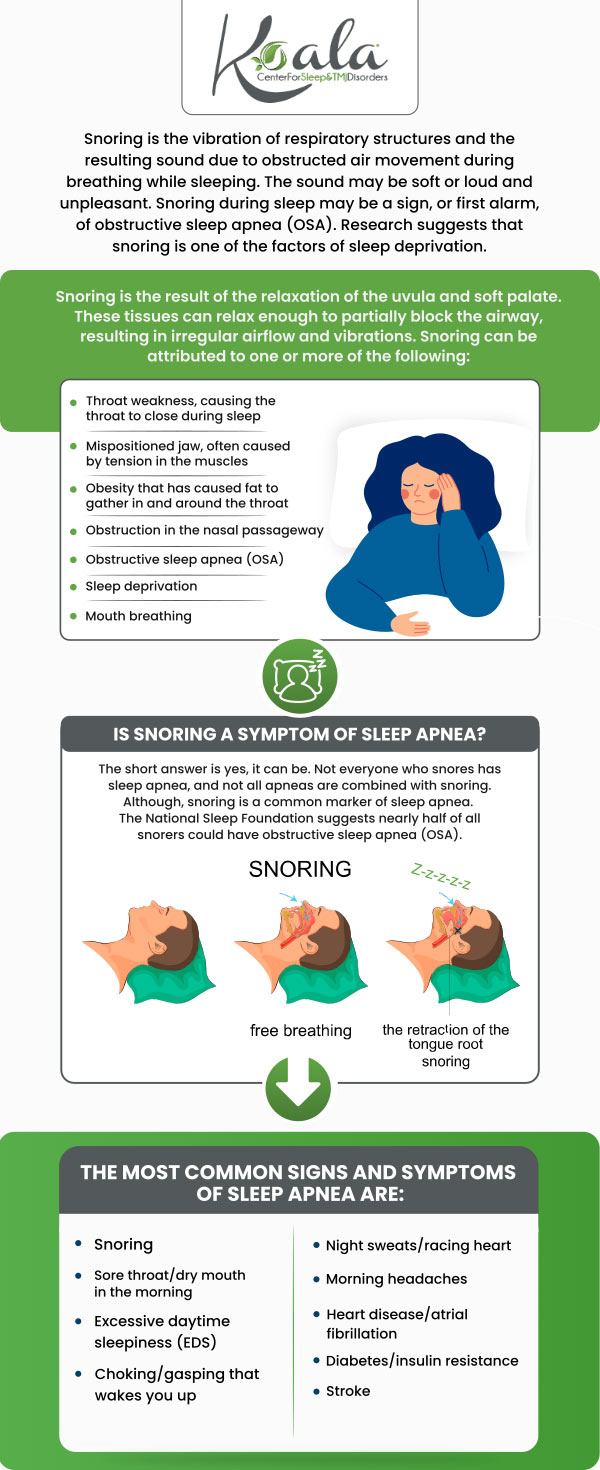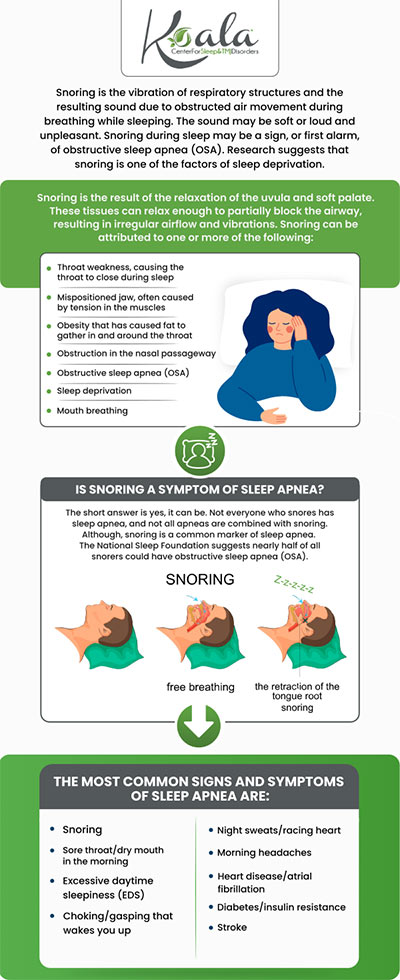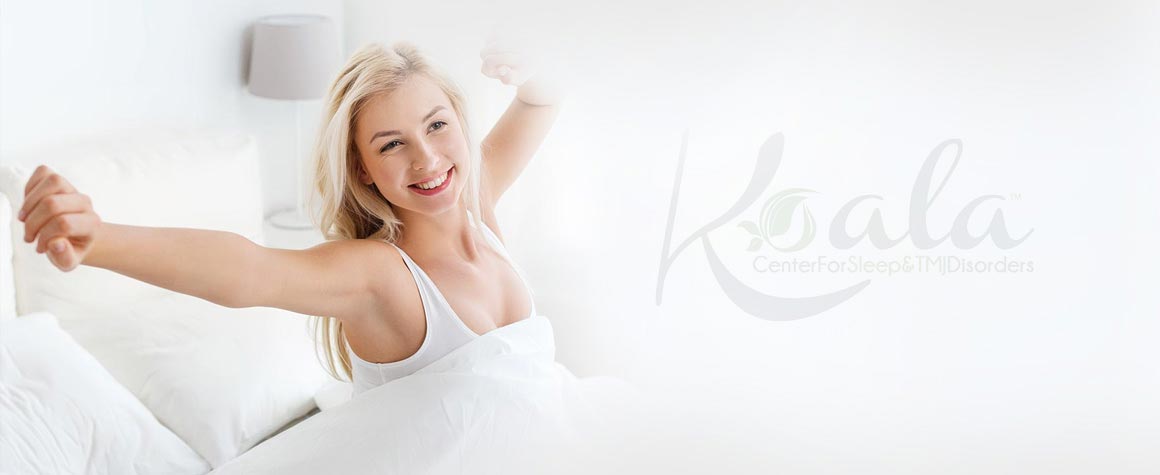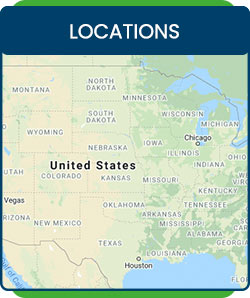Snoring: A Nuisance or a Serious Health Condition?
Tired of waking up your neighbors? We can help you enjoy peaceful nights. Snoring can be more than just a nuisance; it may indicate underlying health issues like sleep apnea. Persistent snoring can lead to poor sleep quality, daytime fatigue, and increased health risks if not addressed. Visit Koala® Center for Sleep & TMJ Disorders and talk to our professionals. For more information, please contact us today or request an appointment online. We have convenient locations in Bloomington IL, Peoria/Dunlap IL, El Paso TX, and Wausau WI.


Table of Contents:
Snoring: A Nuisance or a Serious Health Condition?
What Causes Snoring?
When Snoring Becomes Sleep Apnea
Is Snoring A Serious Problem?
Sleeping with a Snorer
What Are the Treatment Options for Snoring & Sleep Apnea at Koala® Center for Sleep & TMJ Disorders?
Snoring is a common problem among all ages and both genders, and it affects approximately 90 million American adults — 37 million on a regular basis according to the National Sleep Foundation.
“Many of my patients have asked me, “What’s the difference between snoring and sleep apnea?” says Dr. Rod Willey, CEO and Founder of Koala® Center For Sleep & TMJ Disorders. “I tell them that when you sleep, the muscles of your throat relax and your tongue falls backward, causing the airway to narrow. The uvula and soft tissues that surround the throat also become infirm, or “floppy.” As you breathe, these floppy tissues of the throat begin to vibrate as air struggles to enter around them – generally when you breathe in, but also, to a lesser extent, when you breathe out.
These vibrations lead to the characteristic sound of snoring. The more narrow your airway becomes, the greater the vibration and the louder the snoring,” Willey continues.
It starts when the breathing becomes very shallow due to these obstructions in the airway. The sleeper is not able to breathe deeply and take in enough oxygen. “Sometimes the airway completely blocks, causing the person to make a choking or snorting sound and often waking them up in an attempt to breathe,” says Willey. “This condition is known as obstructive sleep apnea.”
Patients with obstructive sleep apnea experience a pattern of similar events that repeat throughout the night, sometimes hundreds of times. The number of breathing pauses per night, the duration of each pause and the lack of oxygen, in part, determine the severity of obstructive sleep apnea.
Not all patients who snore have sleep apnea, and not all patients who have sleep apnea snore. However, because snoring could be a precursor to sleep apnea and is often a symptom of sleep apnea, it should not be ignored.
According to the National Sleep Foundation, breathing pauses can last from 10 seconds to a minute or longer. A person with severe sleep apnea may have hundreds of breathing pauses per night. Sleep Apnea is a serious problem in the United States with over 18 million Americans now suffering from the disorder and 90% of them going undiagnosed.
People with obstructive sleep apnea have a higher risk of death than the normal population. The price they pay includes a potentially crippling deterioration in daily functioning, an increased risk of high blood pressure and stroke, depression, and death either in accidents or in their sleep. There are terrible costs for the family of the person with obstructive sleep apnea, who may experience irritability, mood changes, lowered sexual drive and capacity, and a reduction of intellectual ability. In addition there are major business, insurance, health, and social costs including the loss of productivity, the impact of accidents caused by a driver or worker falling asleep, and the wasted health care dollars spent on alleviating symptoms like heart disease without treating their possible underlying cause.
Studies show that the person with sleep apnea isn’t the only one waking up or suffering from sleep deprivation. When the apnea is followed by loud snorts and snoring, the bed partner may wake up as often during the night as the person with the actual sleep disorder. One study from the Mayo Clinic in Rochester, Minn., found that partners of snorers woke up, at least partially, an average of 21 times an hour, nearly as often as the 27 times the snorers were awakened by their sleep apnea episodes.
In a 2005 study from Finland of 37 male snorers and their bed partners, half of the bed partners reported being disturbed by snoring every night or almost every night. One third of the bed partners reported relationship problems as a result of the snoring.
In a 2003 study published in the journal Chest, doctors from the Mayo Clinic in Scottsdale, Ariz., tracked the spouses of 54 patients with sleep apnea. Once the sleep apnea and snoring were treated, the spouses’ quality-of-life scores surged more than those who received the actual treatment. And treating the apnea also improved sleepiness scores among the spouses by 20 percent.
Treatment options for snoring and/or sleep apnea may include lifestyle changes, surgery, Continuous Positive Airway Pressure (CPAP) and oral appliance therapy.
Oral Appliance Therapy has proven to be a viable and scientifically based treatment option for Snoring and/or Obstructive Sleep Apnea. The American Academy of Sleep Medicine issued a statement in the 2006 journal “SLEEP” that Oral Appliance Therapy was approved as the first line of treatment for those suffering from mild to moderate Obstructive Sleep Apnea and in many cases proving to be effective for severe sleep apnea as well. “The purpose of the oral appliance is to hold the jaw in a position that allows the airway to remain as open and firm as possible during sleep,” says Willey. “Oral appliances are similar to athletic mouth guards but less bulky and completely non-invasive,” he continues. For more information call us today to book an appointment for TMJ treatments. We look forward to serving you!

Additional Services You May Need
▸ KoalaKIDZzz®
▸ Sleep Apnea
▸ Snoring
▸ TMJ Disorder
▸ Fatigue
▸ Sleep Disorders
▸ Weight Loss
▸ CPAP Alternative
▸ Oral Appliances




